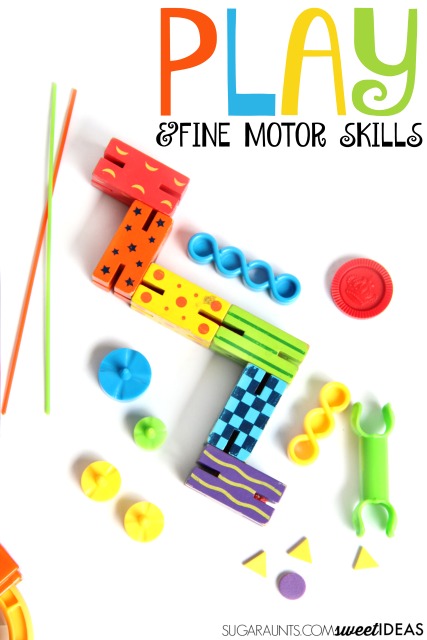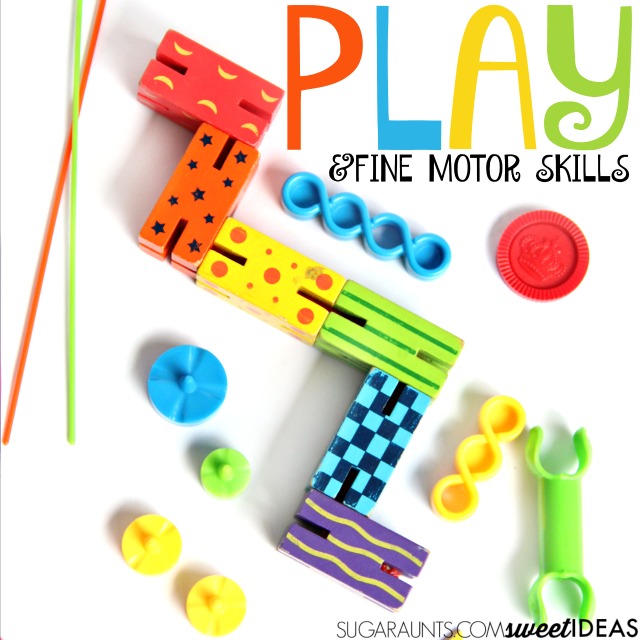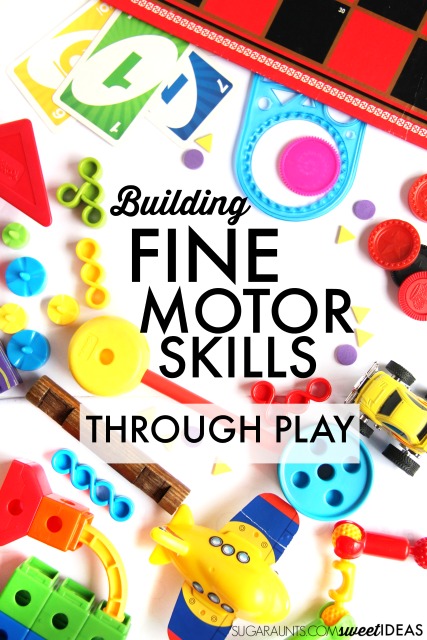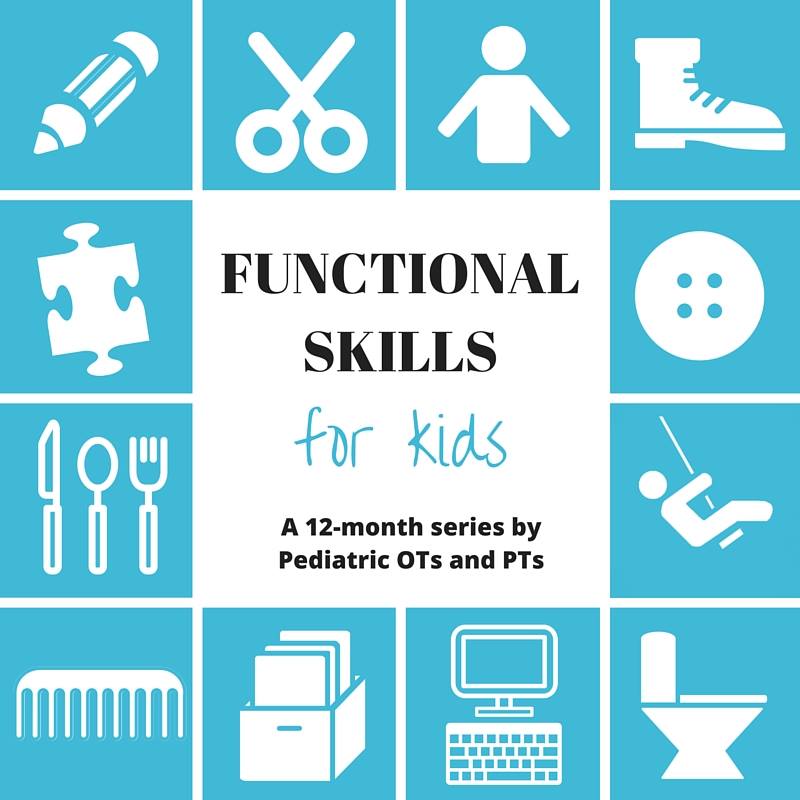Play is a child’s primary occupation. The occupations of a person are the meaningful and purposeful activities and adults have distinctly different occupations than children. A child develops functional skills, learns about their abilities, grows in motor, language, interpersonal skills, and learn the value of their capacities, all through play.
And toys and games are tools of function when it comes to using play to build independence in all tasks.
Today, I’m sharing ways to work on fine motor skills through play.

Use play to develop fine motor skills:
This post contains affiliate links.
Improve Isolation of the fingers through Play- Isolating the individual fingers is needed for tasks such as typing, pointing, and tasks that require moving individual fingers in isolation from the rest of the hand. These skills can be difficult for some children and result in poor pencil grasp and handwriting, shoe tying difficulties, and other functional tasks.
Finger Isolation Ideas
Amazon affiliate links are below.
- Finger games (Where is Thumbkin, Itsy Bitsy Spider)
- Finger puppets
- Finger painting
- Fingerprint art
- Finger Trap
- Animal Shadows on a wall
- Count on individual fingers one at a time
- Paper Football
Motoric Separation of the Two Sides of the Hands- Separation of the two sides of two sides of the hand is important for tasks like holding a pencil while stabilizing the hand along the table, cutting with scissors, tying shoes, holding multiple items in the palm of the hand, and managing coins.
Refinement of fine motor skills in the hand (the radial side) happens when the power half (the ulnar side) is stabilized. A functional fine motor grasp and manipulation of objects is more accurate when the ring and pinky fingers are flexed (bent) into the palm.
An alternative to a flexed position of the ring and pinky fingers are when theses two digits are fully extended out and stretched out away from the hand (abducted). T
his positioning stabilizes the MCP arch and allows for control of the pointer and middle fingers. Separation of the two sides of the hand allow for more precise use of the thumb. Hand separation starts when a baby bears weight through their arm and ulnar side of the hand while carrying a toy in the radial side. This simple activity developmentally lengthens the muscles of the ulnar side.
Separation of the Hand Play Ideas:
- Flip coins
- Roll play dough into small balls
- Squeeze a spray bottle with the pointer and middle fingers
- Pick up small items and “squirrel them away” into the hands: mini marshmallows, cereal, small beads, coins, water beads. (This is also called translation toward the palm.)
- Release the items (This is also called translation away from the palm.) Place coins into a piggy bank or beads into a cup.
- Hold a cotton ball in the palm with the ring and middle fingers while coloring, writing, or cutting with scissors.
Hand Dominance-Hand dominance in children is important for refining the skills needed to perform functional tasks.
While Toddlers begin to show a hand preference, a true hand dominance doesn’t typically develop until 2 to 3 1/2 years. While a toddler can show a hand preference, hand usage is experimented with during different activities throughout the Toddler and Preschool years. There is typically variability in hand preference as toddlers and young preschoolers poke, pick up, throw, color, and play.
Another consideration is that often times, kids of this age are influenced in which hand they choose by position of toy, location of the adult or playmate, method materials are presented, and sitting position of the child.
Lateralization refers to the brain’s ability to control the two sides of the body. Each hemisphere of the brain controls different tasks and functions.
When a child shows difficulties with laterality, they might switch objects between the two hands in functional tasks. As a child grows, they are challenged to become more efficient with tools in school.
True hand dominance may not be completely integrated in the child until around 8 or 9 years of age. Use play activities to build consistency with the child’s preferred hand dominance. If your child shows a preferred hand, set up the activity to work on scooping with the typically used hand. If your kiddo uses their right hand most of they time in natural situations
Hand Dominance Play Ideas:
- Using tools like a hammer or screwdriver
- Threading beads
- Scrubbing and “cleaning” with a towel on walls and windows
- Driving cars on a floor mat
- Scooping beans and beads with spoons, shovels, or scoops
- Catching and tossing bean bags into a target
- Opening and shutting plastic ziplock bags
Open Thumb Web Space- An open thumb webspace is essential for true
opposition of the thumb to the precision side of the hand. A round “O” shape
allows the thumb to rotate and oppose the pointer finger in pincer grasp activities. When kids write or color with that web space area squashed shut, it’s a sign of problems.
Then might be compensating for thumb instability, underdeveloped hand arches, and/or poor strength. Each of these problem areas will lead to difficulties with handwriting, dexterity, manipulation of small items like beads, and pencil grasp. Writing with a closed web space is inefficient and will cause poor and slow handwriting, especially as kids grow and are expected to write at faster speeds. A closed web space while attempting to manage fasteners such as buttons and zippers will lead to fumbling and difficulty.
Open Thumb Web Space Play Ideas-
- Beading (like our idea we shared above!) Other beading ideas include threading plastic beads on a string, placing cereal O’s onto toothpicks, and stringing straws onto yarn.
- Pick-Up-Sticks
- Wind up toys.
- Barrel of Monkeys game. Encourage your child to pick up the monkeys with an open web space.
- A game like Chinese Checkers encourages an open web space when the child grasps the small pegs with a pincer grasp between their thumb and the pad of their index finger.
- You could also try peg games like this HABA Color Peg.
- Push coins into a piggy bank.
- Tweezers activities are great for an open web space.
- If handwriting and poor pencil grasp is an issue, try a pencil grip.
- Pop beads.
- Roll play dough into small balls using the pads of the thumb and index finger. This is a great activity for developing arches of the hands and opening the thumb web space.
- Pop bubble wrap.
- Screw and Unscrew nuts and bolts.
- Fold and crease origami. Crease the paper between the thumb and pointer finger.
- Pinching clothes pins.
- Lacing cards are great for opening the thumb web space. Prompt your child to keep their thumb web space open while managing the thread. We’ve got lots of ideas here.
Precision of Grasp- Precision skills allow a person to manipulate and release of small objects. Precision provides efficient grading movements in very small dexterity patterns like threading a string through a needle.
Difficulty with precise motor movements of the hand may cause fumbling with zippers and buttons and trouble with advancing the pencil on small lines of paper. Precision occurs with development of grasp when child to use the pads of the index finger, middle finger, and thumb to manipulate objects with opposition.
Precision release is needed for stacking blocks without toppling them over, placing cards on a pile, opening scissors just a small amount, or placing small beads into a bowl.
Precision is needed for a child to let go of an item in a controlled manner.
If they are not exercising precision in release, you might see them rolling or tossing an object as they let go. They will knock over a stack of blocks, or over open the scissors when cutting lines, making their accuracy very choppy.
Precision in grasp is related to the picking up of items. A graded lateral grasp is needed to cut with scissors and only squeeze the scissors halfway shut for accurate cutting lines in some situations.
Around 3-4 years, a preschool aged child typically develops a greater variety of grasping patterns, including precision. They begin to grade their scissor strokes so that they can cut a line or shape without opening and closing the scissors completely. Grasps in babies typically begin with a raking motion and work towards a pincer grasp. Precision in this skill occurs when the child is able to pick up very small items like beads with accuracy and graded movements.
Precision in rotation is another task that children develop around age 5. Rotation is a portion of in-hand manipulation and seen when turning a coin on the edges and the child rotates it in a circular motion. Precision in rotation also occurs when holding a pencil between the fingers and the child rotates it over and over.
Precision Fine Motor Play Ideas-
- Perler Fuse Beads with Pegboards
- Stamp sets
- Tweezer games and activities
- Bed Bugs Game
- Avalanche Fruit Stand
- The Perfection Game
- Manipulating beads or pegs on an inclined surface.
- Jenga
- Pick-Up Sticks
- Tobbles stacking toy
- Blocks like Wooden Color Cubes are perfect for simple block building and stacking while working on precision of grasp and release.
- Slide Puzzles for precision of the thumb’s movements.
Neat Pincer Grasp- Neat Pincer Grasp is a precision grasp using the very tips of the thumb and the pointer finger to pick up and hold very small items. Sometimes, the fingernails are used in the grasp of items.
Neat pincer grasp is used to pick up and hold a pin, a needle in sewing activities, or super small beads like Perler Beads. This can be a tricky grasp for kids with difficulties in fine motor skills or core weakness.
Neat Pincer Grasp Play Ideas-
- Threading string into a needle for embroidary art.
- Beading with string
- Quickels or
- Sort small items
- Art or play with tape
Pinch Strength and Control- There are a few different grip postions of the
hand and fingers that are used in play with children. Difficulties in using and
maintaining any certain grasp may interfere with tasks that require using the
hands. Types of grasp patterns include:
- Lateral Pinch Grip (aka Key Pinch Grip)- The thumb opposes the lateral side of the pointer finger. This grasp is used when holding and and using a key. A sub group of this type of pinch is the Lateral Prehension Grip– The thumb is flexed (bent) and it’s pad opposes the lateral side of the tip of the pointer finger. This grip is used to hold an index card or paper, sometimes.
- Three jaw Chuck Pinch Grip– The thumb is flexed (bent) and opposes the pads of the pointer finger and middle finger. Holding a small cap like a toothpaste lid uses this grip. This is the grip used in holding a pencil.
- Tip to Tip Grip– The tip of the thumb touches the tip of the pointer finger. The thumb and pointer finger form an circle (or open thumb web space). This grasp is also called a pincer grasp. It is used to pick up small items like cereal or beads. If very small items are picked up (like a needle), a Neat Pincer Grasp is being used.
- Lateral Grip– Pinching an item between the pointer and middle fingers use this grip. You would use this grip in holding a cigarette. While this is not a functional grasp for kids (obviously), you might see kiddos fiddle with a pencil by holding it between two fingers.
Pinch Strengthening and Control of Grasp Patterns Play Ideas-
- Line the edges of an index card with clothes pins. Try using the different pinches described above.
- Make clothes pins into superheros and pinch them onto strips of paper.
- Paint with Pom Poms (Fantastic Fun and Learning)
- Write letters on each clothes pin and match them to letters written along the edge of a piece of paper like we did here to spell sight words.
- Pinch clothes pins onto a ruler. Encourage pretend play like hanging clothes on a line.
- Use clothes pins to pinch and grab small items like crafting pom poms, small erasers, or crumbled up pieces of tissue paper.
- Craft with rainbow clothes pins.
- Paint wooden clothes pins different colors and clip them to matching paper scraps.
- Create an outdoor scavenger hunt for letters like we did here.
- Wrap clothes pins in colored string and match them to crafting pom poms.
- Make a fun animal craft. These bees were fun to make!
- Make a butterfly garland.
- Create a tree using the clothes pins as the trunks, like in these Cherry Blossom trees.
Gross Hand Strength and Grasp- Gross grasp is used when squeezing all of the fingers shut around an object, like when holding the handle of a suitcase. Gross grasp is important in tasks like handwriting and scissor use.
To do these activities, you need to squeeze your whole hand shut and maintain endurance to complete the activity. Development of hand arch and thumb web space is important for these functional skills and gross grasp plays a part.
Gross Hand Grasp and Strength Play Ideas-
- Squeeze spray bottles
- Squeeze sponges
- Cut resistive materials with scissors.
- Use a hole punch
- Tug of war
- Hand grippers
Flexion of the Thumb IP Joint- Many times a poor pencil grasp or difficulty with precision in opposition is a result of lacking flexion of the thumb Interphalageal joint.
A flexed tip of the thumb is required to grasp and manipulate items such as a pencil, zipper pull, shoe laces, and buttons. If there are muscle weaknesses in the forearm or hand, a hyperextended thumb IP joint will present as a form of providing stability by the thumb.
Instead of using the opposition muscle of the thumb to grasp the pencil, the child is using the adductor muscle. Rather than manipulating items with the tips of their thumb and index finger, the child is using musculature of their wrist and forearm.
In order to improve this grasp, a child needs to strengthen the opposition muscle, Opponens Pollicis, along with Flexor Pollicis Longus to bend the tip of the thumb or the Interphalnageal Joint (IP Joint) of the thumb. Strengthening the intrinsic muscles along with addressing an open web space will improve IP flexion.
Thumb IP Joint Flexion Play Ideas-
- Games that require the thumb to bend
- Where is Thumbkin hand games
- Thumbprint Artwork
Thump Opposition- Thumb oppositon occurs when the thumb is rotated at the
carpometacarpal joint. Opposition of the thumb to the fingertips is essential
for tasks such as holding a hairbrush, managing buttons, and even grasping a door
knob.
Thump opposition coincides with an open web space in functional tasks.
Thumb Opposition Play Ideas-
- Pop Beads
- Pegboard activities
- Wind up toys
- Tong Games and activities
- Stringing beads
- Connecting chain links
- Peeling stickers from a sheet
- Spinning tops
- Geoboards
- Squeezing small glue bottles in crafts
Palmer Arches- In the palm of the hand, there are arches that shape the hand’s grasp on objects of all shapes and sizes.
There are two transverse arches that cross the hand at the carpals and at the metacarpals. There is a longitudinal arch for each finger.
These arches allow for skilled movements of the hands and first develop during crawling. Arch development is essential for manipulating small objects such as a writing utensil.
Palmer Arch Development Play Ideas-
- Finger and hand games like Itsy Bitsy Spider
- Cupping water with the hands in water play
- Shaking dice in the hand
- Using tools to cut play dough
- Pouring and scooping sand
- Tongs games
- Tweezer games
- Squeezing spray bottles
In-Hand Manipulation- This skill is essential for managing small items within the hand for accomplishment of tasks. There are three parts to In-hand manipulation…translation, shift, and rotation.
We shared two fun activities to work on these skills here. In-hand manipulation typically begins to develop around 18 months, with the greatest skill development occurring between 2 and 2 1/2 years old.
There are subcategories of in-hand manipulation.
Finger-to-Palm Translation is the movement of an object from the fingers to the palm i.e. picking up a coin and moving it to the palm.
Palm-to-Finger Translation: Movement of an object from the palm to the finger tips. (i.e. moving a coin from the palm to the fingertips to insert into a vending machine.)
Shift: Slight adjustment of an object on or by the finger pads. (i.e. adjusting a pencil up and down in your hand.)
Simple Rotation: Turning or rolling an object 90 degrees or less with the fingers moving as a unit. (i.e. unscrewing a toothpaste lid).
Complex Rotation: Turning an object more than 90 degrees using isolated finger and thumb movements. (i.e. Turning a paper clip)
Each of the above skills can occur with items “squirreled away in the palm using the pinky finger and ring finger. This is called “with stabilization”. If other items are not pocketed away in the palm while in-hand manipulation occurs, it is called “without stabilization”. Stabilization typically occurs around 2 years of age.
In-Hand Manipulation Play Ideas:
- Lite Brite
- Lacing & Tracing Dinosaurs
- Lacing & Tracing Sea Life cards
- HABA Color Peg
- Peg Board with 1000 Pegs
- Manipulating coins is such a great way to work on in-hand manipulation. A coin bank is a fun bank to practice with!
- Spinning tops like Standard Tops
- Ker Plunk Game
- Roll play dough into small balls using only the fingertips.
- Tear newspaper into strips, crumble it, and stuff an art project.
- Use tweezers to pick up small items. This works on the intrinsic muscles of the hands.
- Lacing cards
- Coin or button matching, sorting, and stacking. We loved playing with coins for fine motor fun.
- Pegboards
- Dropping small items into bottles with a small opening like we did here.
- Pick up beads from the floor and drop into ice cube trays.
- Press buttons into a slit cut in the lid of a plastic tub.
- Pick-up sticks.
- Games with small chips.
- Beading.
- Twisting lids on/off water bottles.
Bilateral Coordination- Bilateral coordination is the functional use of the two hands together in a coordinated manner. It’s coordinating both hands together and is closely related to hand dominance.
When a child has an established hand dominance, there needs to be a fluid use of the two hands together. In development of the child, children use both hands together then progress to using one hand at a time and finally using both hands together.
Refined bilateral coordination skills allow a child to use both hands in separate tasks fluidly.
Bilateral Coordination Play Ideas-
- Lacing cards
- Combining chain links
- Threading beads
- Ball passing games
- LEGOS
- Pop beads
- Spirograph
- Coloring
- Tearing and crumbled paper crafts
- Weaving looms
- Finger weaving
Wrist and Hand Development- A prerequisite to controlled movements of the hand and fingers are strength and stabilization of the wrist. Control in the wrist allows for manipulation of small items and grasps with the fingers A functional position for the wrist in most activities requiring fine motor skills is slight extension and neutral positioning.
This is an optimal position for handwriting or tasks such as manipulating buttons.
Other activities like using a toothbrush or managing a utensil during feeding require slight ulnar deviation. Stabilization of the wrist is essential no matter what the task.
In order to allow precision of fine motor tasks, the wrist should be stabilized in extension with precision tasks performed on a vertical surface, putting the wrist into optimal positioning and facilitating thumb abduction for distal work to the fingers.
Wrist and Hand Development Play Ideas-
- Painting on a chalkboard or easel
- Vertically positioning a Magna Doodle, Etch a Sketch, or pegboard


There are so many fine motor skills that can be addressed through play. Fine motor development is not limited to the ideas, games, toys, and activities listed in this resource. There are many more toys and games that can work on these fine motor skill areas.

This post is part of the Functional Skills for Kids series by 10 Occupational Therapists and Physical Therapists. You can see previous months posts here.
Stop by to see what the other professionals have to say about Play: The Developmental Progression of Play Skills | Mama OT
Gross Motor Skills and the Development of Play in Children | Your Therapy Source Playing with Friends: Supporting Social Skills in Play
Miss Jaime OT Help! My Child Won’t Play – Adapting Play for Individual Kids | Growing Hands-On Kids How Play Makes Therapy Better | Therapy Fun Zone
How the Environment Shapes the Way Kids Play | The Inspired Treehouse
Why is my child “just playing” when they see an OT? | Your Kids OT
Are you looking for more ways to build fine motor skills through play? Let me know what you’re working on!







1 thought on “Building Fine Motor Skills Through Play”
Comments are closed.